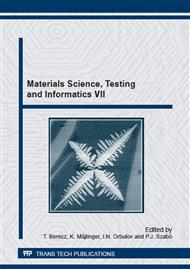p.227
p.233
p.239
p.247
p.253
p.259
p.265
p.271
p.279
Surface Layers Produced by Modified Floe Ferritic Nitrocarburising
Abstract:
Ferritic nitrocarburising is a surface alloying heat treatment, which can provide to components high surface hardness, thus improved wear resistance. In structural steels the porosity of white layer has a key role in wear resistance: the porosity is undesirable. For tool steels the absence of white layer is undesirable. Floe process is one way to decrease the porosity of white layer. During our experiments we applied a modified Floe process on two different steels. The acontol of this process is simpler than conventional process. We measured the micro-hardness as a function of depth from the surface, and we made microscopic examination to analyse the structure of nitrided layer.
Info:
Periodical:
Pages:
253-258
Citation:
Online since:
February 2015
Authors:
Keywords:
Price:
Сopyright:
© 2015 Trans Tech Publications Ltd. All Rights Reserved
Share:
Citation:


